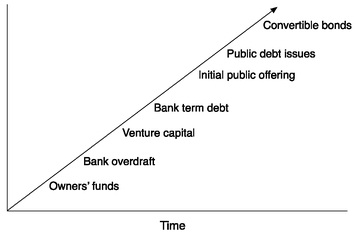Chapter 2
SOURCES OF CAPITAL
Corporate finance at its most fundamental level is about how companies raise capital to run their businesses. Corporate financiers must understand the various sources of corporate funding and how they are combined to achieve an optimal capital structure.
The corporate financier advises on when and how to issue securities, at what price securities should be issued and, in some instances, how to repurchase securities. To do so, s/he must be familiar with the basic funding sources and know where to turn for assistance when considering more complex forms of finance. This chapter provides some detail on the characteristics of the main financial instruments available to companies.
During a company’s life, its reliance on different forms of capital will change as illustrated in
Figure 2.1.
The timing of the use of certain forms of finance will vary and not all companies will make use of each form of capital. However, as you can see from the figure, there are two main forms of capital: debt and equity. The remainder of this chapter describes the primary forms of debt and equity that are available to UK corporations.
A good rule of thumb to keep in mind is that long-term assets such as plant and equipment should be financed with long-term liabilities (long-term debt or equity). Short-term assets such as stocks (inventory) ...


